The average treatment time ranges from 12–18 months, depending on the severity of the gaps and the bite. Mild cases may only take 6–9 months, while widespread gaps accompanied by malocclusion can extend to 24 months. The treatment plan will be personalized after an examination. Join My Auris to learn how long it takes to brace gapped teeth and if gapped teeth can be braced!
What are gapped teeth?
Gapped teeth refer to a condition where teeth are spaced far apart, revealing gaps between adjacent teeth. The most common location is between the two upper front teeth, creating a “gappy smile” appearance. Orthodontic professionals call this condition “diastema,” and it can be effectively corrected with braces, dental bonding, porcelain veneers, or crowns, depending on the severity of the gaps and the specific dental condition.
How long does it take to see results from bracing gapped teeth?
Treatment duration for gapped teeth typically ranges from 12 to 18 months. For mild cases of gapped teeth (gaps between teeth under 2mm), it may only take 6–9 months. Cases with widespread gaps or gapped teeth accompanied by malocclusion often extend to 24 months.
Specific treatment stages:
- First 3 months: Tooth axis movement and basic closing of gaps
- Next 6–12 months: Bite stabilization and consolidation
- Final 3 months: Wearing a retainer to maintain tooth alignment
The treatment plan is personalized depending on the severity of the gaps, age, jawbone condition, brace technique, and the dentist’s experience. Therefore, you should have a direct consultation to receive specific advice.
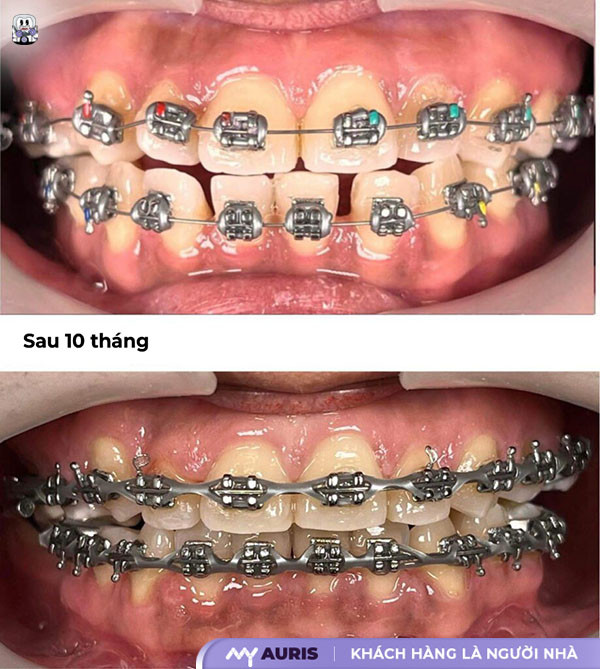
Can gapped teeth be braced?
Gapped teeth can absolutely be braced. In most cases, braces help close gaps, move teeth into their correct positions, improve chewing function, and ensure long-term stability.
When should gapped teeth be braced?
Gapped teeth come in various degrees of severity. For mild cases (1–2 small gaps, especially between the upper front teeth), braces can effectively resolve the issue within just 12–18 months. If gapped teeth are combined with malocclusion, the treatment time may be longer.
Common indications for bracing gapped teeth include:
- Large gap between upper front teeth
- Evenly spaced gaps due to small tooth size
- Irregularly aligned teeth with gaps between multiple teeth
- Gapped teeth after tooth loss or due to bad habits like tongue thrusting
Who doesn’t need braces for gapped teeth?
Not all cases require braces. If the gap is very small (under 1mm) and does not affect aesthetics or chewing function, the dentist might suggest a gentler method such as:
- Composite bonding to close gaps
- Applying thin porcelain veneers to cover gaps
However, the above methods might not maintain long-term results if the underlying tooth structure is not corrected. Therefore, accurately assessing the severity of the gaps and the overall dental condition is a crucial step before deciding on treatment.
Common methods for bracing gapped teeth today
Below are 3 popular methods for bracing gapped teeth widely used and highly regarded at reputable dental clinics.
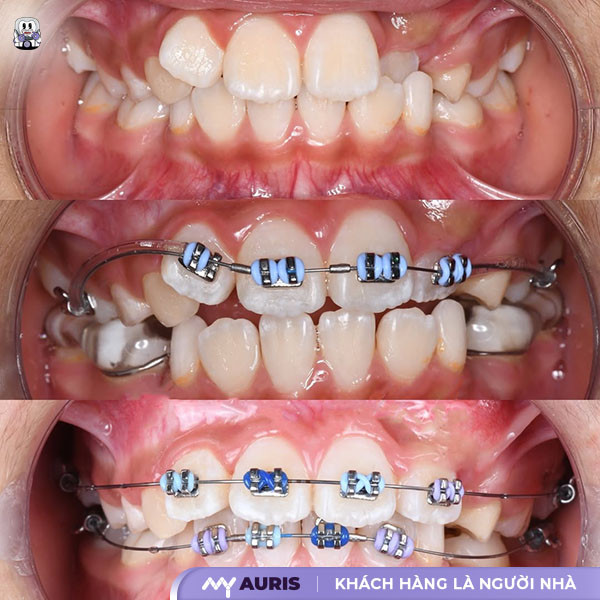
Traditional metal braces
This is a popular, highly effective, and long-standing method for treating gapped teeth. The archwire-bracket system creates consistent pulling force, helping to close gaps quickly.
- Advantages:
- Shorter treatment time for gapped teeth (average 12–18 months)
- Effective for even complex gapped teeth conditions
- Lowest cost among all bracing methods
- Disadvantages:
- Less aesthetic appeal
- May cause discomfort during the first 1–2 weeks
- Requires monthly follow-up appointments
This method is suitable for those who are not overly concerned with aesthetics during orthodontic treatment and wish to save costs.
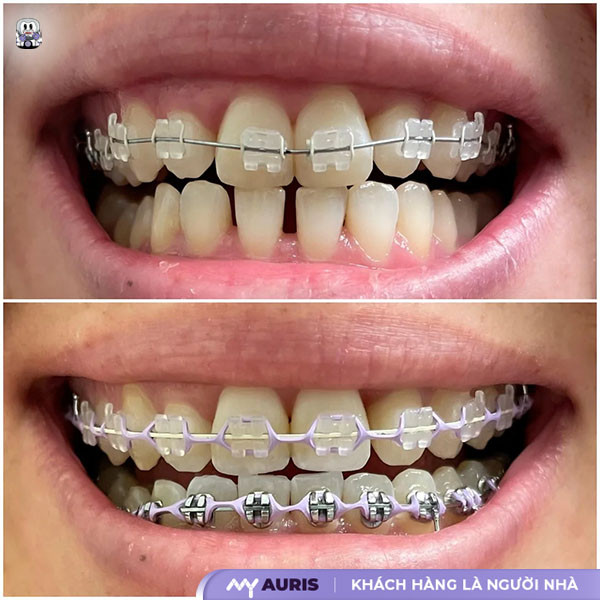
Ceramic braces
This technique is similar to metal braces, but the brackets are made from clear or tooth-colored ceramic. This is a suitable option for adults undergoing treatment for gapped teeth who need to maintain aesthetics during communication.
- Advantages:
- Higher aesthetic appeal
- Effectiveness comparable to metal braces
- Applicable to various degrees of gaps
- Disadvantages:
- Cost 20–30% higher than metal braces
- Brackets can easily break if not careful
- Treatment time might be a few months longer
Office workers or those who frequently communicate often choose this technique because it ensures effectiveness while maintaining confidence.
Invisalign Clear Aligners
Invisalign uses clear plastic aligners instead of brackets. This technique is favored by many due to its convenience and high aesthetic appeal. It represents a significant advancement in modern orthodontic techniques.
- Advantages:
- No one will know you’re wearing braces
- Can be easily removed for eating and cleaning
- Less pain and discomfort
- Disadvantages:
- Highest cost (typically 60–100 million VND depending on the package)
- Suitable for mild to moderate gapped teeth
- Requires wearing for at least 22 hours/day for effectiveness
Invisalign is suitable for individuals with stable finances who need to correct gapped teeth but don’t want it to affect their daily communication or work.
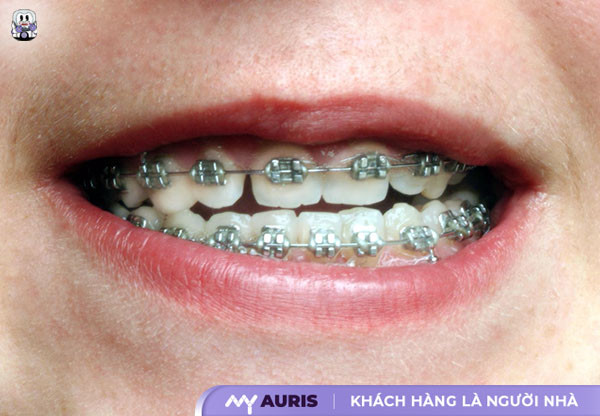
How much do braces for gapped teeth cost? Is it expensive?
The cost of bracing gapped teeth ranges from 25 to 60 million VND, depending on the severity of the gaps, the type of braces, and the dental clinic you choose. Below are the reference prices for common orthodontic techniques:
| Method | Estimated Cost | Characteristics |
| Metal Braces | 25 – 35 million VND | Low cost, high effectiveness |
| Ceramic Braces | 35 – 45 million VND | More aesthetic, easy to clean |
| Sapphire/Crystal Braces | 40 – 50 million VND | Transparent, hard to detect, prone to breakage |
| Invisalign Clear Aligners | 50 – 70 million VND | Flexible removal, invisible braces |
This is the average cost for the entire treatment, from bracket placement to brace removal and retainer wear.
Factors affecting the cost of bracing gapped teeth
Severity of gaps: The larger the gaps, the longer the treatment time and the higher the cost.
Number of gapped teeth: If only 1-2 front teeth are gapped, the cost will be lower compared to a full arch of gapped teeth.
Age of bracing: Adults often have more stable teeth but harder jawbones, making orthodontics more challenging.
Type of braces: Ceramic, sapphire/crystal, or clear aligners all have higher prices than traditional metal braces.
Dental technique and dentist’s expertise: Dentists with >5 years of orthodontic experience and modern techniques will help reduce treatment time and risks, although the cost might be slightly higher.
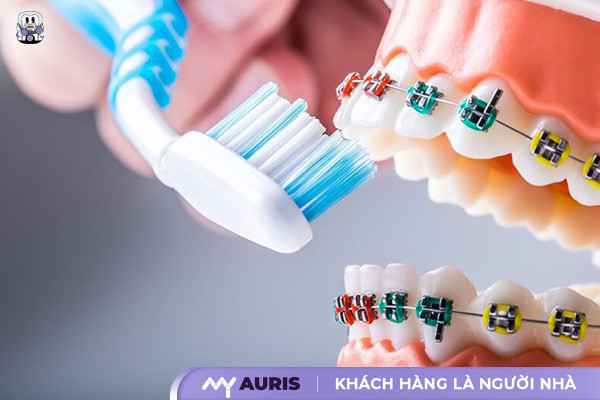
How to care for and maintain results after bracing gapped teeth
After braces are removed, teeth still risk shifting or developing new gaps if not properly cared for. To maintain stable bracing results, you should follow these steps:
Immediately after brace removal, the dentist will prescribe a retainer. Initially, it needs to be worn 22 hours/day for 3–6 months, then only at night. Absolutely do not stop wearing it without instruction. The retainer can be clear or fixed, depending on the case.
Use a soft toothbrush, dental floss, or a water flosser to thoroughly clean your teeth daily. Brush after meals and rinse with salt water or a specialized solution to reduce plaque and gingivitis.
Regular check-ups help detect early signs of tooth movement. You should visit the dentist monthly for the first 6 months, then every 3–6 months as per the dentist’s instructions.
Avoid hard, excessively hot, or excessively cold foods. Do not bite hard objects with your teeth. Chew evenly on both sides to prevent bite imbalance and protect newly stabilized teeth.
The effectiveness of braces depends not only on the dentist but also on you. Gapped teeth can be braced and their alignment significantly improved. However, for long-term stable results, proper care must be maintained for at least 1–2 years after brace removal.





